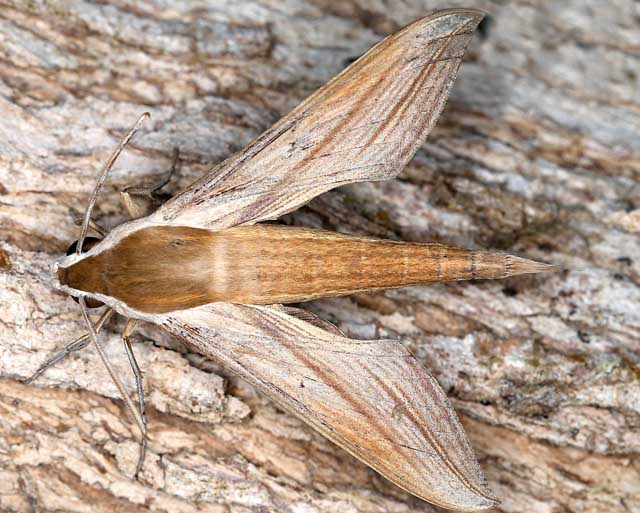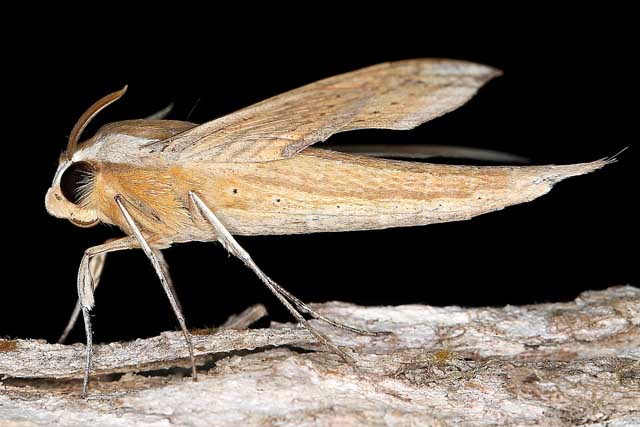Xylophanes loelia
|
| left">
Updated as per
AN ANNOTATED CHECKLIST OF THE SPHINGIDAE OF BOLIVIA, October 2007
Updated as per More, Kitching and Cocucci's Hawkmoths of Argentina 2005, October, 2007
Updated as per personal communication with Ezequiel Nunez Bustos (Osununu Private Reserve, Misiones, Argentina, November 24, 2009); December 2009
Updated as per CATE (Venezuela, Belize, Ecuador, Brazil, Argentina, Nicaragua); March 5, 2011
Updated as per personal communication with Gregory Nielsen (Meta, Colombia, February 28, 2011, 500m); March 5, 2011
Updated as per French Guiana Systematics: Sphingidae: May 18, 2011
Updated as per personal communication with Rodrigo Torres Nunez (74 mm, Cundinamarca, Colombia, November 9, 2010); May 22, 2011
Updated as per personal communication with Johan van't Bosch (Palumeu, Sipaliwini District, Suriname, July 10, 2011); November 21, 2012
Updated as per personal communication with Brian Fletcher (Podocarpus NP, Zamora-Chinchipe, Ecuador, February 5, 2014, 1100m); March 11, 2014
Updated as per personal communication with Sergio D. Ríos Díaz in CATÁLOGO DE LOS SPHINGIDAE (INSECTA: LEPIDOPTERA) DEPOSITADOS EN
EL MUSEO NACIONAL DE HISTORIA NATURAL DEL PARAGUAY; sent to me in July 2014 by Sergio D. Ríos Díaz.
Updated as per personal communication with Steve Nanz (Cuffie River Nature Resort, Tobago, March 27, 2015); March 29, 2015
Updated as per personal communication with Ezequiel Bustos (Shilap revta. lepid. 43 (172) diciembre, 2015, 615-631 eISSN 2340-4078 ISSN 0300-5267), January 4, 2016
Updated as per personal communication with Sergio Messias (Londrina, Parana, Brazil, March, 2019); March 18, 2019
Updated as per personal communication with Gernot Kunz (El Copan, Cartago, Costa Rica, March 6, 2019, 1047m); April 16, 2019
|
Xylophanes loelia
zail-AH-fan-eesM
LEEL-ee-uh
(Druce, 1878) Choerocampa

Xylophanes loelia male courtesy of Paolo Mazzei.

Xylophanes loelia, El Copan, Cartago, Costa Rica,
March 6, 2019, 1047m, courtesy of Gernot Kunz.

Xylophanes loelia (verso), El Copan, Cartago, Costa Rica,
March 6, 2019, 1047m, courtesy of Gernot Kunz.
It is quite difficult to distinguish between X. loelia, libya and cthulhu. There might be a mix of those three species on this page.

Xylophanes loelia, Copalinga Lodge, Podocarpus NP, Zamora-Chinchipe, Ecuador,
February 5, 2014, 1100m, courtesy of Brian Fletcher, id by Bill Oehlke.
This site has been created by Bill Oehlke.
Comments, suggestions and/or additional information are welcomed by Bill.
TAXONOMY:
Family: Sphingidae, Latreille, 1802
Subfamily: Macroglossinae, Harris, 1839
Tribe: Macroglossini, Harris, 1839
Genus: Xylophanes Hubner [1819] ...........
Species: loelia Druce, 1878
|
DISTRIBUTION:
Xylophanes loelia (approximate wingspan: males: 66-74mm; females: 70-72 mm) fly
from
southwestern Belize: Cayo; to
Nicaragua;
Costa Rica; and
Panama; to
Colombia: Meta; Cundinamarca (RTN)
Venezuela;
Trinidad and Tobago: Cuffie River Nature Resort (SN);
Suriname: Sipaliwini District: Palumeu;
French Guiana: Kaw;
Ecuador: Zamora-Chinchipe;
Peru
to
Bolivia: Beni: Yacuma (300-800m); Santa Cruz: Santa Cruz
(350m);
Brazil: Parana: Londrina (SM);
Argentina: Misiones: Iguazu.
They may also be in Paraguay: Amambay; Canindeyu; (possibly Itapua (WO??)).
I expect it also flies in Guyana.
heinrichi Closs, 1917, Peru, is the same as Xylophanes loelia.

Xylophanes loelia, Cundinamarca, Colombia,
74 mm, November 9, 2010, courtesy of Rodrigo Torrez Nunez.

Xylophanes loelia, El Copal, Cartago, Costa Rica,
March 6, 2019, 1047m, courtesy of Gernot Kunz.

Xylophanes loelia (verso), Cundinamarca, Colombia,
74 mm, November 9, 2010, courtesy of Rodrigo Torrez Nunez.

Xylophanes loelia, Palumeu, Sipaliwini District, Suriname,
July 11, 2011, courtesy of Johan van't Bosch.
Xylophanes loelia is intermediate between Xylophanes libya and Xylophanes neoptolemus, but has a closer resemblance to the
latter. The hindwing of X. loelia is narrower than in Xylophanes libya.
Compared to Xylophanes libya, this species lacks a black dot in discal cell opposite CuA2, and a subapical costal dot is only rarely indicated.

Xylophanes loelia male, courtesy of Hubert Mayer
copyright.
Forewing underside as in Xylophanes libya but: first postmedian line thin, continuous, more oblique and not as dark (occasionally absent);
second and third postmedian lines faintly indicated; fourth postmedian line not as conspicuous.
Hindwing upperside with median band redder than in Xylophanes libya but paler than in Xylophanes neoptolemus, reaching the costal margin and with an
irregular inner edge; marginal band more even than in Xylophanes libya, narrow, sharply defined, not dentate near M2.
Hindwing underside with postmedian lines straighter than in Xylophanes libya, not divided into spots; inner edge of marginal band more even and continuous than in Xylophanes libya, less basally projecting between M1 and M3.
Outer spur of midtibia always longer than inner, but often not conspicuously so, especially in the female.
Mark Vincent has advised me that those specimens from Minas Gerais, Brazil, previously thought to be X. loelia, are now designated as
Xylophanes lolita.

Xylophanes loelia, COLOMBIA Depto Meta,
Villavicencio, km 13 via Acacias, 04°03’55.0 N 073°41’87.0 W;
500m 28- ii-2011 leg. G. Nielsen
The pronunciation of scientific names is troublesome for many. The "suggestion" at the top of the page is
merely a suggestion. It is based on commonly accepted English pronunciation of Greek names and/or some
fairly well accepted "rules" for latinized scientific names.
The suggested pronunciations, on this page and on other pages, are primarily put forward to assist those who hear with internal ears as they read.
There are many collectors from different countries whose intonations and accents would be different.
Jean Marie Cadiou writes, "When I say "Xylophanes" in English I
pronounce it something like "Zailophanees", with the emphasis on the "o". The French pronounce it differently, something like
"Kzeelophaness" with no emphasis, and the Germans yet in a different way..."
"Xylophanes" sounds like it is from Greek mythology.
Loelia may have been chosen for Loelia, one of the vestal virgins.
FLIGHT TIMES:
Xylophanes loelia, adults probably brood continuously with pupae emerging after rains. In Costa Rica
moths have been taken in every month of the year. Ezequiel Nunez Bustos reports a November flight in Misiones, Argentina. Gregory Nielsen reports a
February 28, 2011, flight in Meta, Colombia. Rodrigo Torres Nunez reports a November 9-10, 2010, flight in Cundinamarca, Colombia.
Specimens have been taken in French Guiana in February. Steve Nanz reports a late March flight in Tobago. Johan van't Bosch reports a July flight in southern Suriname.
Sergio Rios Diaz reports March and September flights in Paraguay.

Xylophanes loelia, Osununu Private Reserve, Misiones, Argentina,
November 24, 2009, courtesy of Ezequiel Nunez Bustos.
ECLOSION:
Pupae probably wiggle to surface from subterranean chambers just prior to eclosion.

Xylophanes loelia, Cuffie River Nature Resort, Tobago
March 27, 2015, courtesy of Steve Nanz.

Xylophanes loelia, Cuffie River Nature Resort, Tobago
March 27, 2015, courtesy of Steve Nanz.

Xylophanes loelia male, Londrina, Parana, Brazil,
March, 2019, courtesy of Sergio Messias.
SCENTING AND MATING:Females call in the males with a pheromone released from a gland at the tip of the
abdomen. Males come in to lights very readily, but females are seldom taken in that way.

Xylophanes loelia female courtesy of Dan Janzen.

EGGS, LARVAE, PUPAE:
Larvae probably feed on Psychotria horizontalis, Psychotria nervosa, and
Psychotria microdon of the Rubiaceae family.
Use your browser "Back" button to return to the previous page.
Goto Main Sphingidae Index
Goto Macroglossini Tribe
Goto Central American Indices
Goto Carribean Islands
Goto South American Indices
Goto U.S.A. tables
Use your browser "Back" button to return to the previous page.
This page is brought to you by Bill Oehlke and the
WLSS. Pages are on space rented from Bizland. If you would like
to become a "Patron of the Sphingidae Site", contact Bill.
Please send sightings/images to Bill. I will do my best to respond to requests for identification help.
Enjoy one of nature's wonderments: Live Saturniidae (Giant Silkmoth) cocoons.
 | 
Show appreciation for this site by clicking on flashing butterfly to the left.
The link will take you to a page with links to many insect sites. |


















